Biodynamic wines are wines made employing the biodynamic methods both to grow the fruit and during the post-harvest processing. Biodynamic wine production uses organic farming methods while also employing soil supplements prepared according to Rudolf Steiner's formulas, following a planting calendar that depends upon astrological configurations, and treating the earth as "a living and receptive organism."

Savennières is a commune in the Maine-et-Loire department in western France.

Château-Grillet is a wine-growing AOC in the northern Rhône wine region of France, near Vienne, which produces white wine from Viognier grapes. The whole appellation, which is only 3.8 hectares in size, is owned by a single winery, Château-Grillet. The appellation was officially created in 1936.
A monopole is an area controlled by a single winery and can be as small as a named vineyard (lieu-dit) or as large as an entire appellation d'origine contrôlée (AOC). Frequently this is mentioned on the label as it is rare for only one winery to produce all the wine from an area entitled to a certain name. Each wine is sold by only one company.

French wine is produced all throughout France, in quantities between 50 and 60 million hectolitres per year, or 7–8 billion bottles. France is one of the largest wine producers in the world, along with Italian, Spanish, and American wine-producing regions. French wine traces its history to the 6th century BCE, with many of France's regions dating their wine-making history to Roman times. The wines produced range from expensive wines sold internationally to modest wines usually only seen within France such as the Margnat wines were during the post war period.
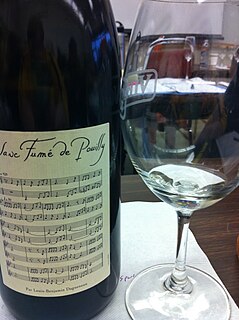
Pouilly-Fumé is an appellation d'origine contrôlée (AOC) for the dry sauvignon blanc white wine produced around Pouilly-sur-Loire, in the Nièvre département. Another white wine produced in the same area but with a different grape variety is called Pouilly-sur-Loire.
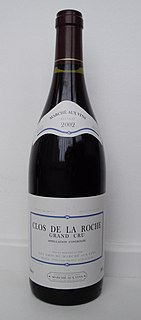
Clos de la Roche is an Appellation d'origine contrôlée for red wine in the Côte de Nuits subregion of Burgundy, with Pinot noir as the main grape variety. It is situated in the commune of Morey-Saint-Denis in the Côte-d'Or département. Clos de la Roche is located in the northern part of the commune, stretches to the border of Gevrey-Chambertin, and borders to the Grand Cru vineyard Clos Saint-Denis in the south. It borders the Route des Grands Crus in the east. The AOC was created in 1936, and the Clos part of its name refers to a wall-enclosed vineyard.
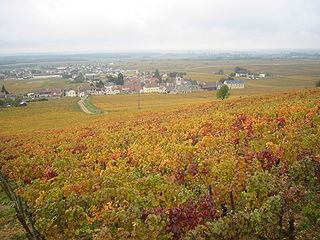
Clos Saint-Denis is an Appellation d'origine contrôlée (AOC) and Grand Cru vineyard for red wine in the Côte de Nuits subregion of Burgundy, with Pinot noir as the main grape variety. It is situated in the commune of Morey-Saint-Denis in the Côte-d'Or département. Clos de la Roche is located just to the north of the village Morey-Saint-Denis and borders to the Grand Cru vineyard Clos de la Roche in the north. The AOC was created in 1936, and the Clos part of its name refers to a wall-enclosed vineyard.

Provence (Provençal) wine comes from the French wine-producing region of Provence in southeast France. The Romans called the area provincia nostra, giving the region its name. Just south of the Alps, it was the first Roman province outside Italy.

A clos is a walled vineyard. Walled vineyards protected the grapes from theft and may improve the mesoclimate. They were often the vineyards of Cistercian monasteries. The word is often used in the name of famous wines even when the wall no longer exists.

Savennières wine is a white wine, usually dry, produced from Chenin blanc around Savennières in the Loire Valley. The vineyards are situated on the north bank of the river Loire, in the Anjou-Saumur subregion.
Clos de la Coulée de Serrant is a French wine AOC and monopole. The winemaker is Nicolas Joly, who specializes in biodynamic wine.

Anjou wine is produced in the Loire Valley wine region of France near the city of Angers. The wines of region are often grouped together with the wines of nearby Saumur as "Anjou-Saumur". Along with the wines produced further east in Touraine, Anjou-Saumur make what is collectively known as the "Middle Loire" (as opposed to the "Upper Loire" which includes the wine regions of Sancerre and Pouilly-Fumé. Within the Anjou wine region are several Appellation d'origine contrôlées responsible for a broad spectrum of wines including still red, white and rosé produced with varying levels of sweetness. Extending across the Deux-Sèvres, Maine-et-Loire and Vienne départements, the generic Anjou AOC appellation and its various sub-appellations encompasses vineyards across more than 151 communes.

Maranges wine is produced in the communes of Cheilly-lès-Maranges, Dezize-lès-Maranges and Sampigny-lès-Maranges in Côte de Beaune of Burgundy. The Appellation d'origine contrôlée (AOC) Maranges may be used for red and white wine with respectively Pinot noir and Chardonnay as the main grape variety. The production consists of around 95% red wine and 5% white wine. There are no Grand Cru vineyards within the Maranges AOC.
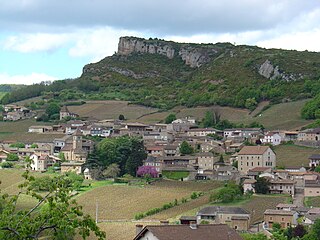
Saint-Véran is an Appelation d'Origine Contrôlée (AOC) for white Burgundy wine from the Mâconnais subregion, located in the department of Saône-et-Loire. It is named after the commune of Saint–Vérand.
Buzet is an Appellation d'Origine Contrôlée (AOC) for wine in South West France, in the department of Lot-et-Garonne.
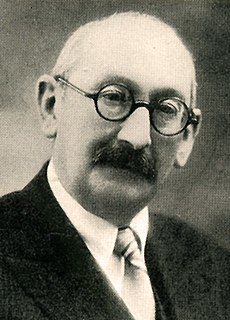
Joseph Marie Capus was a French agriculturalist and expert on grape vines. He became a deputy in the French national parliament, and was Minister of Agriculture for a few months in 1924. He was active in legislation related to agriculture and was the driving force behind introduction of the Appellation d'origine contrôlée for French wines.

Château de Pommard is a winery in Pommard, Burgundy, France. Established in 1726, the property is known for its two Châteaux, gardens, and its 20 hectare walled vineyard, Clos Marey-Monge. The Châteaux, the vineyard and the winemaking facilities are operated and owned by Michael Baum, who purchased the estate in 2014. The winery produces "Clos" wines – Pinot Noir produced from the fruit of Clos Marey-Monge and "Family" wines – Grand Cru, Premier Cru, Village and Bourgogne wines from Chardonnay and Pinot Noir appellations across the Côte de Nuits and the Côte de Beaune. In 2016, the estate tested biodynamic methods on 2.5 hectares of vines, and stated the intention of being entirely biodynamic for the 2019 vintage.














